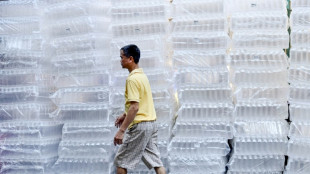

Louisiana residents brace for Hurricane Francine
Hurricane Francine was due to barrel into Louisiana Wednesday, forecasters said, warning of life-threatening flooding and storm surge as residents of the southern US state rushed to board up businesses and stockpile emergency supplies.
The Category 2 storm was packing sustained winds of 100 miles (155 kilometers) per hour and could bring up to 10 feet of storm surge and 12 inches of rain in some parts of Louisiana, the National Hurricane Center (NHC) said.
Flooding, rain and winds could already be seen Wednesday afternoon in some towns along the state's Gulf coast, including at a cemetery and in other neighborhoods in the coastal village of Dulac.
In nearby Houma, residents were filling sandbags, stocking up on supplies and filling their cars with gas ahead of the storm's arrival.
"We're working hard to stay here as long as we can ... to, you know, to take care of our people," a gas station manager who gave her name as Alicia B. told AFP.
"Hurricane-force winds in the northern eyewall of Francine are nearing the coast of southern Louisiana," NHC said, adding that landfall would come within hours. "Now is the time to stay inside and away from windows."
The NHC said the storm is expected to quickly weaken as it moves inland over Louisiana and neighboring Mississippi.
Louisiana Governor Jeff Landry has declared a state of emergency, and on Tuesday requested a federal emergency declaration from President Joe Biden, which he quickly approved.
"This federal assistance will be pivotal to save lives and property," Landry said in a statement thanking the president on X.
The Louisiana National Guard said on X that its soldiers were fuelling up vehicles in preparation for the storm. On Tuesday, it said it was mobilizing helicopters, boats and supplies for evacuations and search and rescue.
Schools and universities around the capital Baton Rouge were preemptively closed until Friday, according to a government website.
Curfews starting as early as 6:00 pm local time (2300 GMT) were issued for communities across the Louisiana capital region, local media reported.
Low-lying Louisiana was the site of one of the most devastating hurricanes in US history, Hurricane Katrina, which killed more than 1,300 people as it slammed into populous New Orleans in late August 2005, overwhelming the city's levee system and causing extensive flooding.
At the mouth of the Mississippi River, Louisiana is a major US trade hub with a significant part of its economy linked to the oil and natural gas industry.
The 2024 Atlantic hurricane season, which began on June 1 and will end on November 30, was expected to be busy but has seen just three hurricanes so far, reportedly puzzling scientists.
Hurricane Beryl became the earliest highest-level Category 5 storm on record after it formed in late June and plowed through the Caribbean, eventually hitting Texas and Louisiana, with dozens of deaths reported in its wake.
Scientists say climate change likely plays a role in the rapid intensification of storms because there is more energy in a warmer ocean for them to feed on.
A.Pérez--ESF



